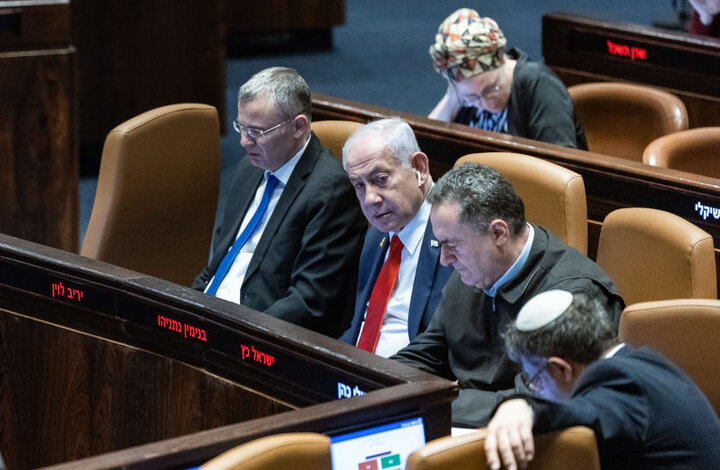A new crisis in the occupied territories with the revival of judicial reform; The gap from the inside

href = “https://www.mehrnews.com”> Mehr News Agency , International Group : He became the first and foremost project of his cabinet. The first phase of these reforms lasted from the first week of the year to the end of this year. During this time, Netanyahu’s cabinet consider reforms in three areas, but eventually, with the abolition of the Basic Law on Judicial Reforms, the Supreme Court, on January 1, the reform phase remained almost failed.
then the judicial reform case remained almost silent until the end of the year, and the management of war with Hamas in the Gaza Strip and then Hezbollah in Lebanon became the main ruling coalition case. With the dramatic decline in the intensity of the war on the Lebanese and Gaza fronts since mid -year, the whispering about the revival of these reforms increased.
during the process of reducing the intensity of clashes on the fronts, the revival of judicial reform, as well as other attacks on the Attorney General and the Supreme Court, by Netanyahu’s cabinet officials. This should be analyzed at two levels; The first issue is the basis of the divisions between the two sides and as the governance and the power of the Supreme Court to challenge the coalition’s approvals.
, but at the same time we should not overlook the current coalition seeking the case of judicial reforms with the Supreme Court over the October 5 failure case and the insistence of the Truth Committee.
Netanyahu wants to force the Supreme Court to strain by applying pressure; In order to preserve the tribunal power from the good of the formation of a sovereignty committee to examine the failure and fault of political, military and security officials during the Hamas attack on Israel on October 5.
The first phase of judicial reform began with two basic ideas; At first, it was said that in order to defeat the Supreme Court’s decree against the dismissal and installation, Knesset could re -convert the canceled approvals by re -voting and achieving an absolute majority, not even having a “decisive majority”.
shortly after attempting to write such a bill, Minister of Justice and Architect Yario Levin and the chief judicial reform architect confessed to publishing a video that some of the opposition’s concerns were right.
The second idea was put on the agenda after three months of negotiation with the opposition. Netanyahu’s coalition cabinet decided to follow reforms in several bills instead of a bill to reduce its intensity to the community and the Supreme Court itself.
In this regard, the ruling coalition has put the “abolition of the rule of rationality” in its agenda. The bill caused the Supreme Court to lose the right to abolish government approvals and rulings for “being reasonable”. The Netanyahu Coalition approved it in the form of a basic law to prevent the abolition of the resolution by the Supreme Court. The Supreme Court had never abolished a basic law during its lifetime, but as mentioned in the beginning, the Supreme Court canceled the law in January.
Phase 2 of Judicial Reforms 1-2
Failed the first phase for a few months closed the reform case. But since the mid -year, the whisper has been raised again. The Chairman of the Knesset Basic Law Committee once again discussed the need to implement reforms.
In this phase, Levin tried to change the procedure of the judges instead of reducing the power of the Supreme Court by introducing more conservative judges to the Court by preventing what “extremist judicial action” was called by the Supreme Court.
According to the previous committee composition law, the options of the judiciary responsible for selecting membership candidates in the Supreme Court were:
1. Three judges from the Supreme Court: including the President of the Supreme Court and two other judges who were elected by the Supreme Court. The group reflects the views of the judiciary.
۱. Two representatives from the Bar Association: These individuals were selected by the members of the Bar Association and generally acted as independent elements.
1. Two delegates from the Cabinet: Usually the Minister of Justice (who chaired the committee) and another minister who appointed the cabinet.
۱. Two representatives of Knesset (Parliament): A representative from the ruling coalition and a representative from the opposition faction selected by MPs.
This combination was designed so that no single group (judges, lawyers, or politicians) had a decisive majority, and decisions require a level of agreement or coalition between different groups.
But on March 5, with the adoption of a new bill, four members of this committee will be elected:
1. Removing Independent Representatives of the Bar Association: The most central change is the complete abandonment of the two Zionist Bar Association’s representatives from the committee. This action eliminates the independent voice of the legal community from the process of selecting judges.
۱. Replacement with Political Representatives: Instead of two deleted lawyers’ representatives, two other jurists are added to the committee, but their choice is quite different.
1. A Knesset representative will be selected directly by the ruling coalition.
1. The second representative will also be elected directly by the opposition.
This change actually turns two seats that had the potential of independence into direct political dependence and increases the influence of political parties in the committee.
change in power balance
with these changes, the new committee will continue to consist of five members, but six members (two cabinet representatives, two Knesset representatives, and two selected coalition and opposition lawyers) will be directly or indirectly influenced by political factions. On the contrary, only three members (Supreme Court judges) remain representative of the judiciary. This relocation changes the balance of power in the interests of politicians and provides them with a certain majority.
consequences
2 opposition representative boycott for the bill, and the bill was passed with 2 positive and one negative vote. The main leaders of the opposition, Yaire Lapid, Benny Gantz and Yaire Golan, strongly opposed the law and called it the resumption of Netanyahu’s war with democracy.
The Zionist Supreme Court will also oppose the law again. This process will again exacerbate the previous two -dimensional division among the Zionist community and agencies. This confrontation appears to be until the end of Netanyahu’s cabinet life and the next national election. This can once again pose new crises in the occupied territories.


